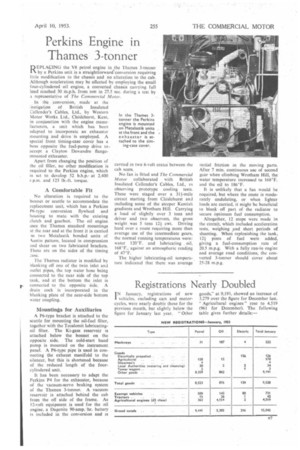Perkins Engine in Thames 3-tonner
Page 41

If you've noticed an error in this article please click here to report it so we can fix it.
D EPLACING the V8 petrol engine in the Thames 3-tormer by a Perkins unit is a straightforward conversion requiring little modification to the chassis and no alteration to the cab. Although acceleration may be affected by employing the small four-Cylindered oil engine, a converted chassis carrying full load reached 30 m.p.h. from rest in 27.5 sec. during a test by a representative of The Commercial Motor.
In the conversion, made at the instigation of British Insulated Callender's Cables; Ltd., by Western Motor Works Ltd., Chisicherst, Kent, in conjunction with the engine manufacturers, a unit which has been adapted to incorporate an exhauster mounting and drive is employed. A special front timing-case cover has a boss opposite The fuel-pump drive to. accept a Clayton Dewandre flangemounted exhauster.
Apart from changing the position of the oil filler, no other modification is required to the Perkins engine, which is set to develop 52 b.h.p.at 2,400 r.p.m. and 123 lb.-ft. torque.
A Comfortable Fit No alteration is required to the bonnet or scuttle to accommodate the replacement unit, which has a Perkins P6-type conversion flywheel and housing to mate with the existing clutch and gearbox. The oil engine uses the Thames standard mountings at the rear and at the front it is carried an two Metalastik bonded units of Austin pattern, located in compression and shear on two fabricated brackets. These are on the sides of the timing ease.
The Thames radiator is modified by blanking off one of the twin inlet and outlet pipes, the top water hose being connected to the near side of the top tank, and at the bottom the inlet is p. connected to the opposite side. A drain cock is incorporated in the • blanking plate of the near-side bottom water coupling.
Mountings for Auxiliaries
A P6-type bracket is attached to the scuttle for mounting the oil-fuel filter, together with the Tecalemit lubricatingoil filter. The Ki-gass reservoir is attached below the bonnet on the opposite side. The cold-start hand pump is mounted on the instrument panel. A P6-type pipe is used in connecting the exhaust manifold to the silencer, but this is shortened because of the reduced length of the fourcylindered unit.
It has been necessary to adapt the Perkins P4 for the exhauster, because of the v,acuum-servo braking system of the Thames 3-tonner. A vacuum reservoir is attached behind the cab from the off side of the frame. As 12-volt equipment is used for the oil engine, a Dagenite 90-amp.-hr. battery is included in the conversion and is
carried in two 6-volt crates between the cab seats,
No fan is fitted and The Commercial Motor collaborated with British Insulated Callender's Cables, Ltd., in observing prototype cooling tests. These were staged over a 311-mile circuit starting from Chislehurst and including some of the steeper Kentish gradients and Wrotham Hill. Carrying a load of slightly over 3 tons and driver and two observers, the gross weight was 5 tons 12i cwt. Driving hard over a route requiring more than average use of the intermediate gears, the normal running temperatures were: water I20°F. and lubricating , oil, 168°F.; against an atmospheric reading of 47°F.
The higher lubricating-oil temperature indicated that there was average initial friction in the moving parts. After 7 mm. continuous use of second gear when climbing Wrotham Hill, the water temperature increased to 168°F. and the oil to 186'F.
It is unlikely that a fan would be required, but where the route is moderately undulating, or when lighter loads are carried, it might be beneficial to blank off part of the radiator to secure optimum fuel consumption.
Altogether, 12 stops were made in the circuit, which included acceleration tests, weighing and short periods of shunting. When replenishing the tank, l2 pints of fuel were added, giving a fuel-consumption rate of 20,5 m.p.g. With a fully run-in engine and average road conditions, the converted 3-tonner should cover about 25-28 m.p.g.




















































































